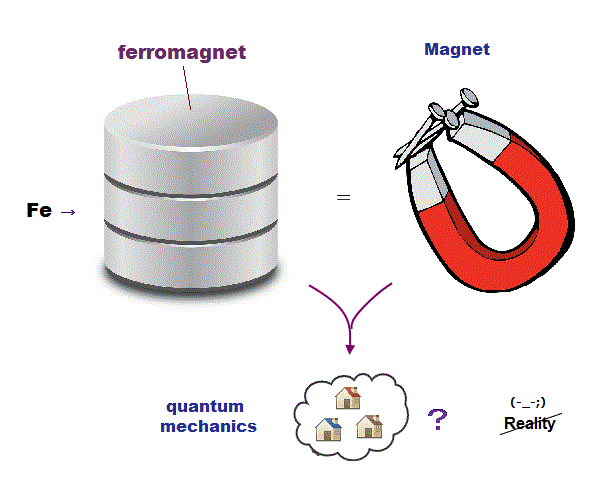
(Fig.1) Iron (= Fe ) forms permanent magnet. Why ?

It is known that certatin materials such as iron form permanent magnets, or are attracted to magnets, which is called ferromagnetism.
What causes this magnet in iron (= Fe ) ? Quantum mechanics can tell us the true reason for ferromagnet ?
Unfortunately, the present quantum mechanics avoids true mechanism inside solid, and escapes into fictional quasiparticle and unreal spin !
(Fig.2) But electron "spinning" speed is much faster than light, so unreal !
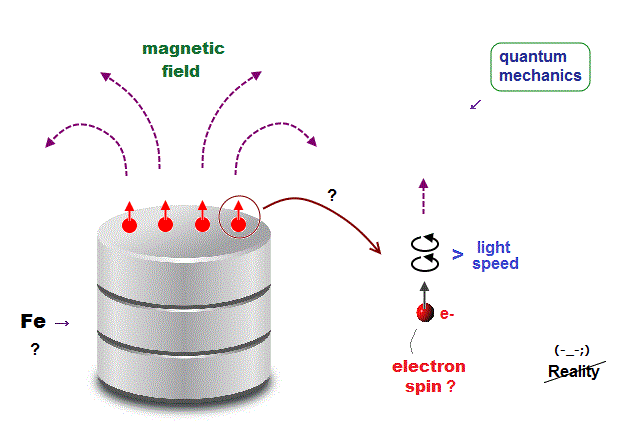
The present quantum mechanics claims when electron spins are aligned parallel, it causes ferromagnetism in iron.
But an electron is so tiny and point-like that its spinning speed must be much faster than light ( > c ) to cause its magnetic field. So this "spin" model is unrealistic.
(Fig.3) Just "three abstract letters" (= JSS ) mean actual ferromagnet ?
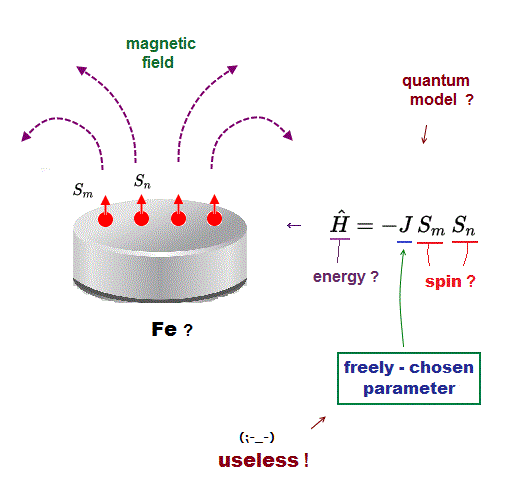
How does the present quantum mechanics describe the actual ferromagnetism in iron magnet ? In fact, quantum mechanics has NO ability to explain actual phenomena.
They just put three simple letters side by side to express ferromagnet.
This spin model is too abstract to deal with actual complicated phenomena !
Here, "S" denotes "electron spin" at each atomic position, and "J" means the strength of their spin-spin interaction. That's all.
This spin interaction parameter J is freely chosen and adjustable ( NOT gotten from the original spin postulate ! ), so useless and can predict nothing.
(Fig.4) Quantum spin model is meaningless, it just chooses "parameter" !
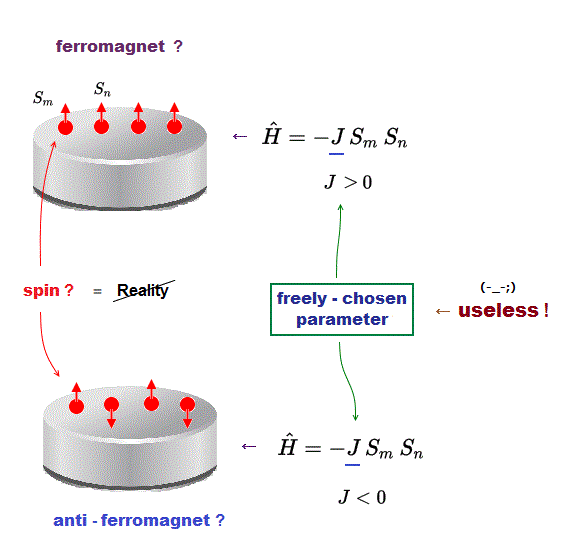
They claim that ferromagnetism arises when a collection of atomic spins align such that their associated magnetic moments all point in the same direction.
"J" is a coupling paramter between the adjacent atomic spins ( this p.6 ).
The problem is this parameter J has nothing to do with the original spin.
They choose positive J, when they want to express ferromagnet, and choose negative J in case of anti-ferromagnet. That's all.
Electron spin's magnetism is too weak to generate actual Fe ferromagnet at room temperature. So physicists invented artificial concept = "exchange energy".
(Fig.5) ↓ Spin model is broken at room temperature !
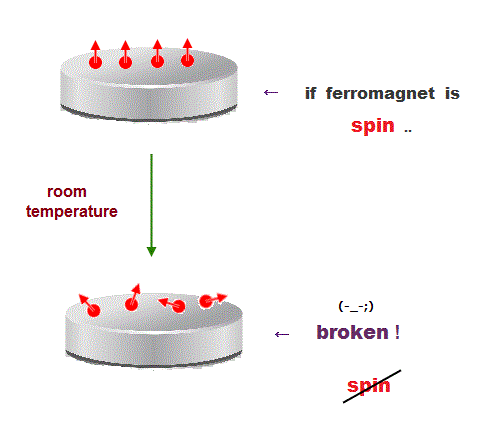
Quantum mechanics claims that (anti)ferromagnetism is caused by electron spin. But this is a big lie.
The magnetic energy by electron spin is too weak to cause ferromagnet.
Spin-spin interaction is easily broken at low temperature ( ~ 0.3 K ).
But actual iron can keep ferromagnetic at 1043 K ( this p.7 ).
In fact, electron's spin disagrees with many experimental results !
"Spin" is used only as a "mark" with No physical meaning.
So we must give up contradictory spin model to investigate further mechanism !
It's natural to think that ferromagnet is maintained stably by Coulomb interaction among electrons' orbits ( not spin ! )
(Fig.6) The magnitude of electron spin is just equal to Bohr magneton

In Stern-Gerlach experiment, they got some atoms through magnetic field to measure the magnitude of magnetic moment of each electron ( spin ).
Surprisingly, the experiments showed that the magnitude of magnetic moment of electron spin is just equal to Bohr magneton in Bohr's classical orbit ( this p.4 )
We can safely say Stern-Gerlach experiment proved the magnetic property in Bohr's orbit ( Not unreaslitic spin ! )
(Fig.7) Spin magnet is too weak to explain ferromagnet.
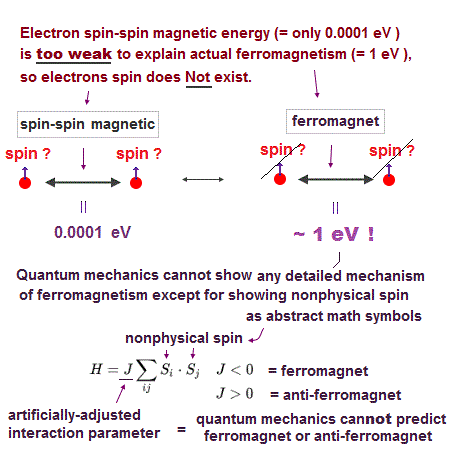
You may think Spintronics and excitonics are useful (← ? ) for your career.
But almost nobody knows electron spin lacks reality !
Its spinning far exceeds
light speed.
You may hear spin is tiny magnet with the magnitude of Bohr magneton.
This spin magnet can explain stable ferromagnetism ? Unfortunately NOT.
Spin-spin magnetic interaction is too weak to explain actual ferromagnet.
See this p.6 this p.7. So spin model failed from the beginning.
Then, what the heck does this spin model mean ?
It uses "Heisenberg" spin model ( this p.3 ).
But this Heisenberg spin model is too old, which was introduced in 1920s, and it's too abstract to describe actual phenomena ( this p.2 ).
This spin model just puts nonphysical symbols side by side. So useless.
Parameter J is arbitrarily chosen. J > 0 = antiferromagnet, J < 0 = ferromagnet.
(Fig.8) Heisenberg spin model is too abstract to use in actual materials.
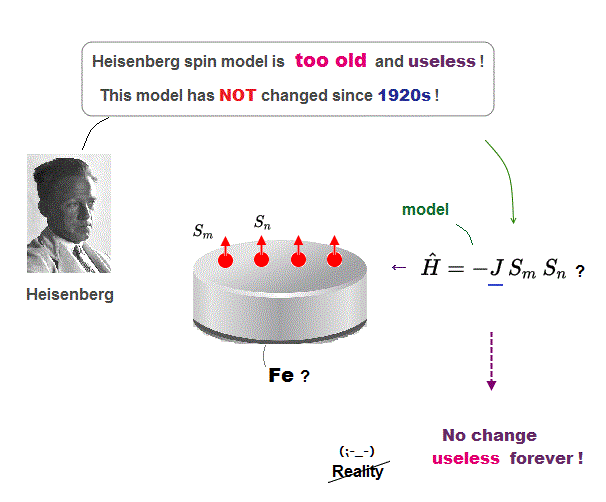
The problem is this spin model has NOT changed since Heisenberg invented in 1920s as very simple and abstract form ( this p.2 ).
It's impossible to describe complicated phenomena in actual materials using only these simple three letters (= JSS ).
This spin interaction strength J has nothing to do with the original spin magnetism seen in Stern-Gerlach. Spin is too weak to cause actual ferromagnet ( this p.6 ).
This is the reason why physicists just choose convenient values as spin parameter J, which means this spin model has NO ability to predict any values.
As long as we stick to this old and unrealistic spin model, it impedes the progress of our science.
(Fig.9) Orbital motion is stable due to Coulomb interaction between atoms.
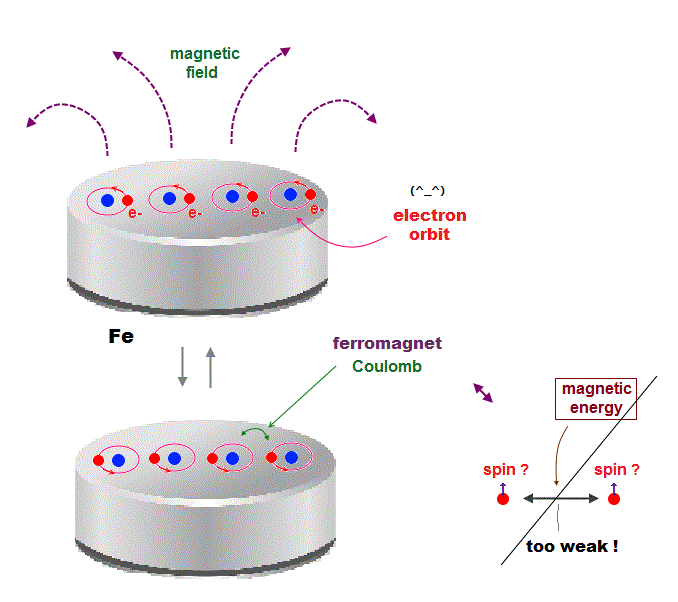
As I said, electron spin magnetism ( measured by Stern-Gerach ) is too weak to cause actual stable ferromagnetism.
This is the reason physicsits invented artifcial concpet (= "exchange force" ) in ferromagnet and Pauli exclusion principle, and parameter J is freely chosen, so useless.
Instead of relying on artificial "exchange force", we can naturally explain this stable ferromagnetism using realistic electron's orbital motion.
Each electron orbital motion synchronizes with neighboring ones to generate macroscopic magnet due to Coulomb attraction between electron and nucleus.
Coulomb force is far stronger and more stable than "spin magnetic" interaction, and this orbital motion can explain why iron ferromagnet is stable even at high temperature
(Fig.10) ↓ Bogoliubov quasiparticle = create + annihilate electron ?
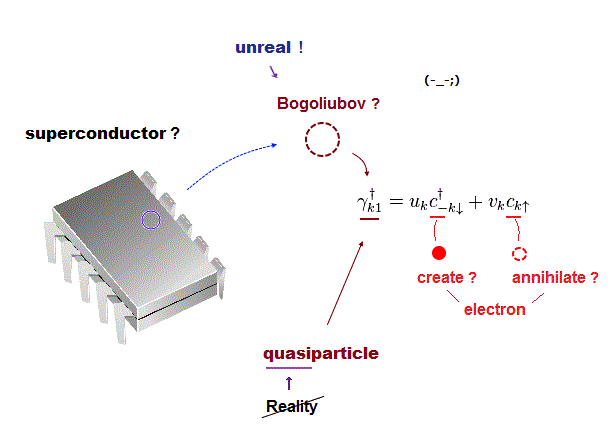
Even in superconductor, quantum mechanics depends on unreal Bogoliubov quasiparticle, which doesn't really exist.
How is this fictitous Bogoliubov quasiparticle created ?
They say this quasiparticle consists of creation and annihilation of an electron.
It means Bogoliubov is a mixture of an electron appearing and disappearing ? Then the total becomes "zero particle" ( this p.4 ) ? Very strange.
This is the reason why this irrational quasiparticle cannot be called "real particle". Of course, useless.
This unreal Bogoliubov quasiparticle is used in fictional Hawking radiation.
(Fig.11) ↓ Quantum mechanics cannot describe actual superconductor.
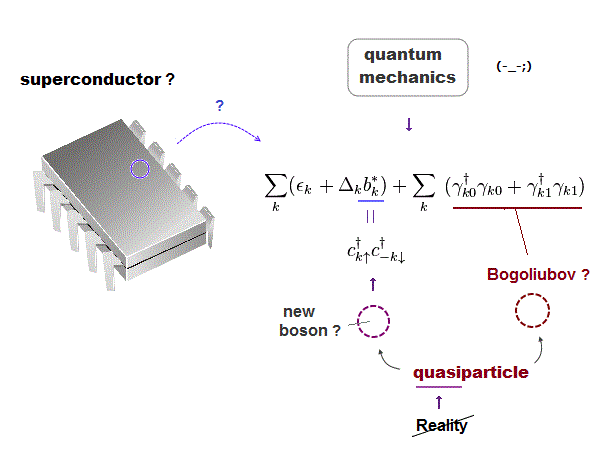
Then how does quantum mechanics apply these unreal quasiparticles to actual superconductor ?
To apply fictional particles, they have to define artificial equation, first.
Each electron can be expressed as only "create" and "annihilate" operators.
So the basic procedure of useless quantum mechanics is,
① Choose artificial equation → ② Replace it by unreal quasiparticle.
All these equation and quasiparticle transformation are artificially made, Not representing the actual nature ( this p.19 ).
We must quit meaningless math trick immediately and aim to describe actual phenomena using only "real concepts" for making the present physics useful.

2016/6/10 updated. Feel free to link to this site.